What has become of the old titans?
Hold on a minute! If that sounds familiar you would be right to have noticed: in a recent article on Urwerk’s new UR-111C I discussed how some titans of American industry, Harley-Davidson and Ford Motor Company, have made some significant shifts of late that have altered their futures. These changes involve innovation and a desire to keep pushing the boundaries of their industries as they work to stay on top as thought leaders, both with the introduction of electric vehicles (Harley-Davidson) and the move toward autonomous vehicles (Ford).
In that article, I focused on the positives of the innovation rather than the potential backlash and confusion. Many of the most passionate fans of Harley-Davidson value classic American ideals like freedom of the open road and the bond between a man and his machine. The dedication and connection of a rider to his or her bike is often said to be as significant as to that of a dog or even family.
So with the switch to electric bikes heralding the future of motorcycles, many worry about the possible connection to a machine they won’t have the tools or knowledge to fix.
The same goes with autonomous vehicles, which individuals perhaps won’t even own, instead using them as a part of a subscription service and thus permanently severing the relationship between drivers and their cars (or trucks).
Most people have a passionate wish for things to stay the same as they grew up with. And at this point, generations have strong memories of iconic brands; it comes as a shock to think that these may fundamentally change.
Without the comfortable familiarity that decades or even centuries of time brings, newer brands create a sense of ownership and pride by allowing people to follow and participate in the nascent growth and success of young companies. This is what motivates fans of independent watchmakers: the opportunity of witnessing the rise of them, and in many cases having supported their success.
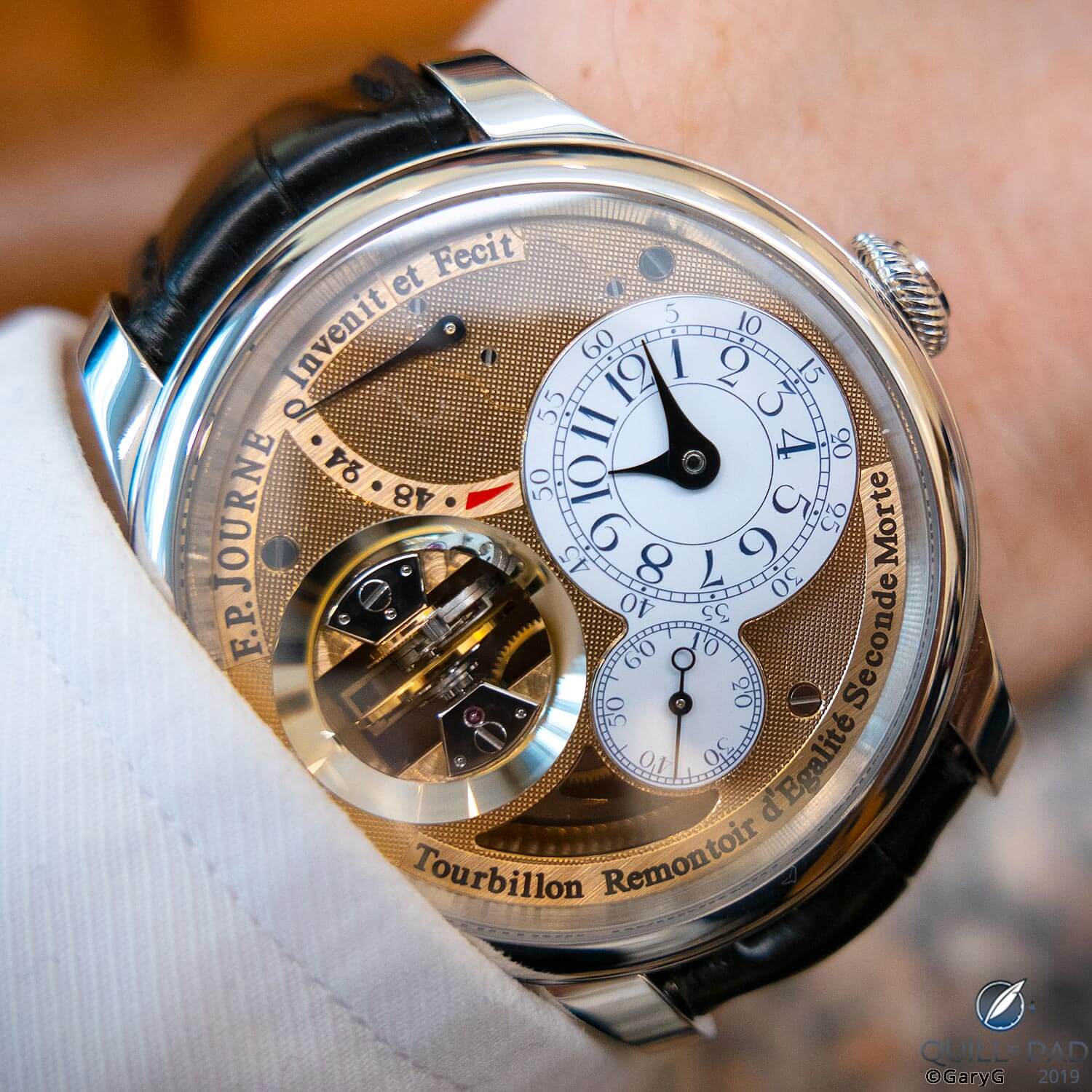
F.P. Journe Tourbillon Souverain Vertical on the wrist
F.P. Journe: a watch industry icon
This brings me to F.P. Journe, one of the most coveted brands in independent watchmaking, led by one of the most talented of contemporary watchmakers.
F.P. Journe has grown over the last 20 years, and many of the brand’s most passionate and loyal collectors have been there since the beginning. That loyalty also begets scrutiny in every decision the brand makes.
The recent acquisition of Chanel‘s twenty-percent stake in F.P. Journe caused a bit of a stir among collectors, though François-Paul Journe calmed emotions by making it clear that the move was to preserve the legacy and longevity of F.P. Journe as a brand so it will continue after he retires and his children do not take over (see GaryG’s take on this in Big Brand Investments In Independents: Sellout Or Salvation?).
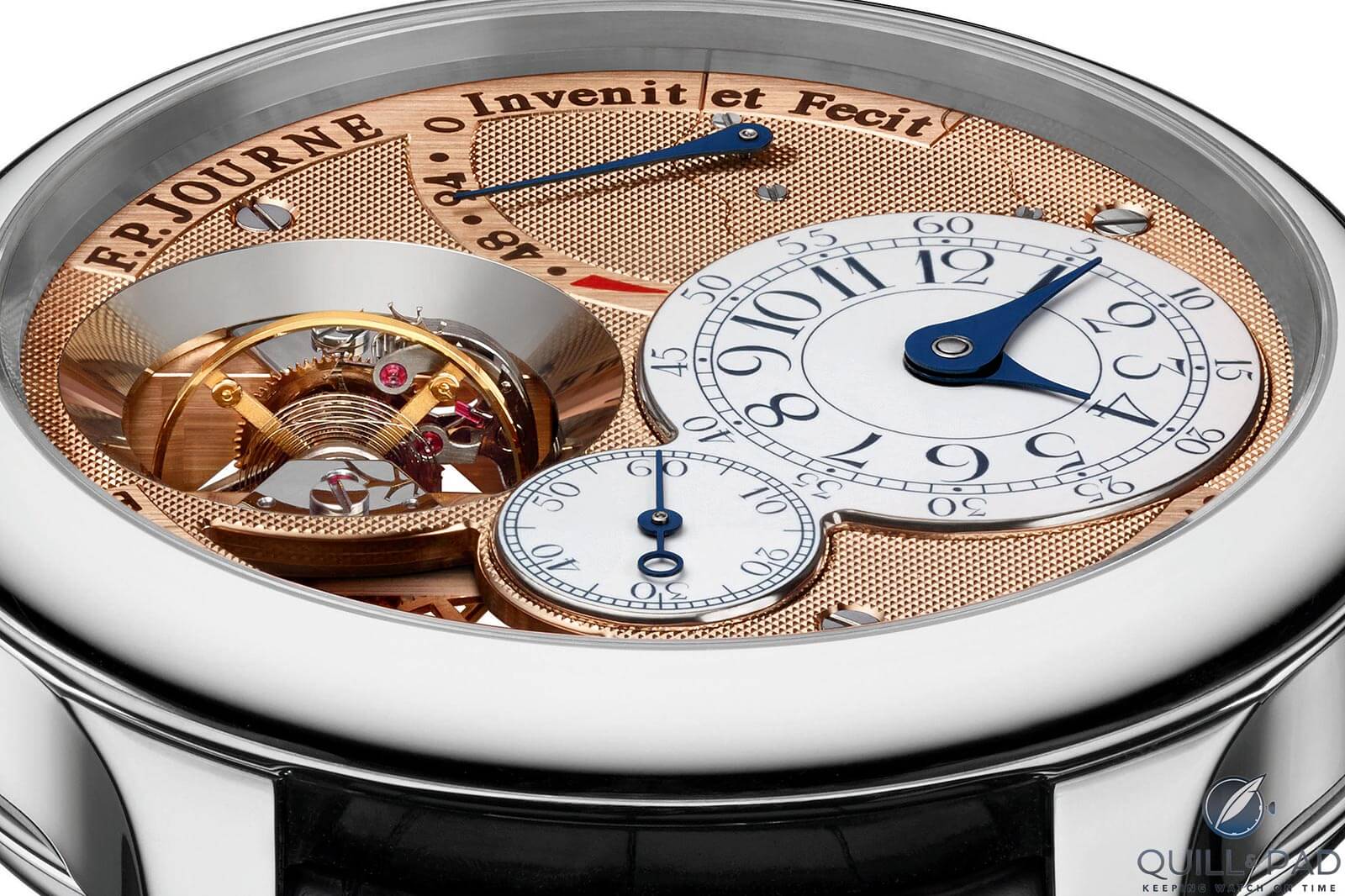
F.P. Journe Tourbillon Souverain Vertical
Now another ripple has sent waves through the horological community in the form of a new watch, the Tourbillon Souverain Vertical: an incredible take on the traditional idea of a tourbillon, which has many of the most passionate F.P. Journe lovers sitting up and taking notice.
That is because, at least according to some, it is very un-Journe in a way. I disagree, but based on the loyalty of the collectors and their beliefs in what F.P. Journe should be, even according to what François-Paul Journe said himself many years ago, this is a dramatic departure from the norm.
And that seems worry people. But of course it shouldn’t, and I think you’ll see why.
F.P. Journe Tourbillon Souverain Vertical: so what is it?
But first, what is the Tourbillon Souverain Vertical?
In short, it is the replacement for the already iconic Tourbillon Souverain (yes, you read that correctly: replacement), an entirely different take on tourbillon movement architecture that seeks to return to the days of Breguet in one subtle but important way. Its basis, you might have guessed, is a vertically oriented tourbillon placed perpendicular to the movement.
Visually, the Tourbillon Souverain Vertical follows many of the F.P. Journe stylistic codes including the small, offset time display with raised dials, power reserve indication, characteristic hand shape, dial engraving, and color palette. Inside, the movement features the remontoir d’égalité and deadbeat seconds found in the previous Tourbillon Souverain.
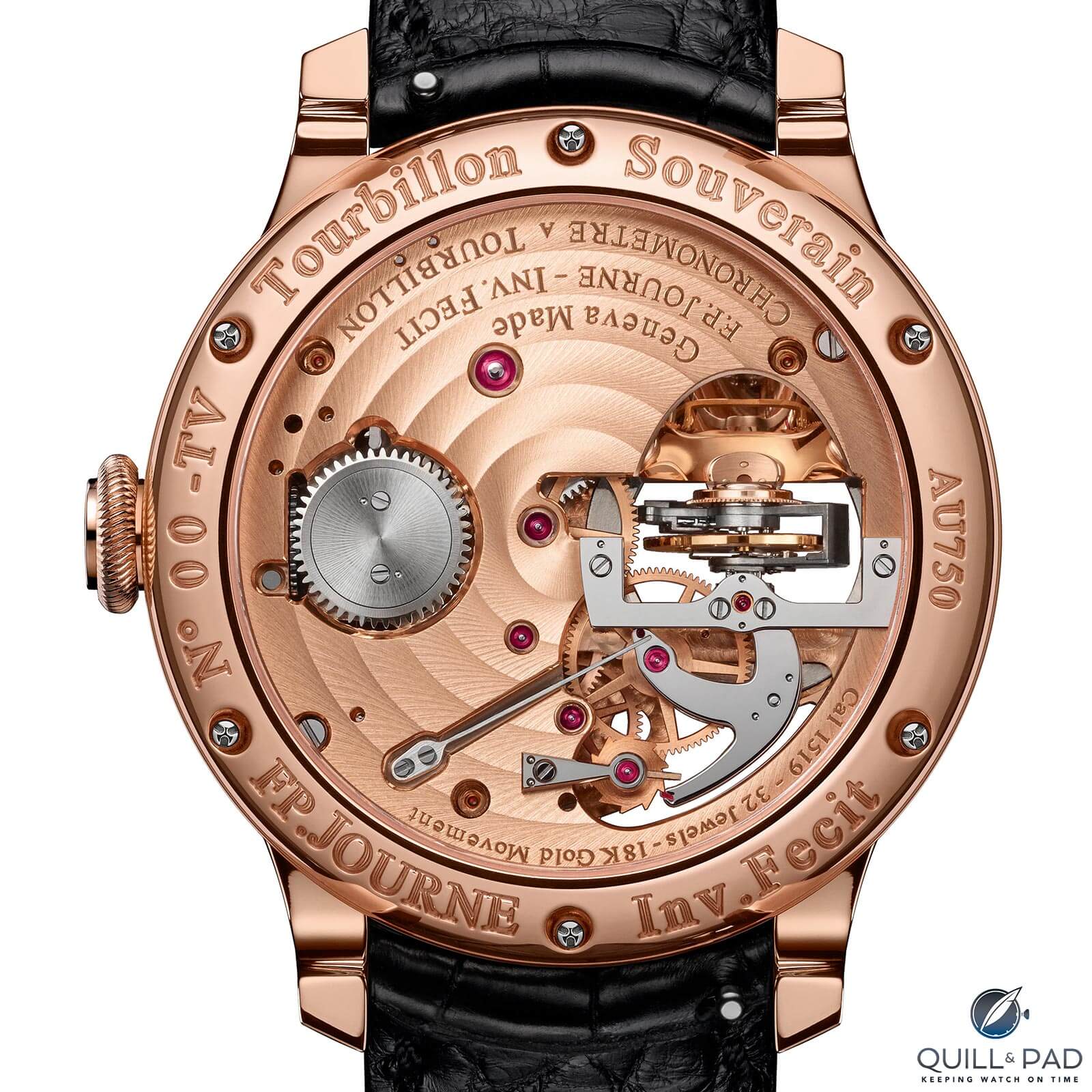
View through the display back to the gold movement of the F.P. Journe Tourbillon Souverain Vertical
The 18-karat gold movement and simple-yet-impeccable finishing is present, as is the clean and balanced case with one of the best crowns in the watch industry.
If it wasn’t for the vertical tourbillon in a massively beveled window, the Tourbillon Souverain Vertical might slip under the radar. But that tourbillon stands out like nobody’s business. The vertical orientation creates a large window area, and F.P. Journe has decided that a large, conical, mirrored bevel is the ideal companion to emphasize the mechanics.
What’s more, that bevel isn’t just in the dial; the dial is actually the movement’s base plate.
This is an intentional decision to keep the height of the movement and case as thin as possible, which is always a requirement for an F.P. Journe timepiece. A clue to this can be seen near the power reserve as the section is actually a bridge supporting the power reserve mechanism.
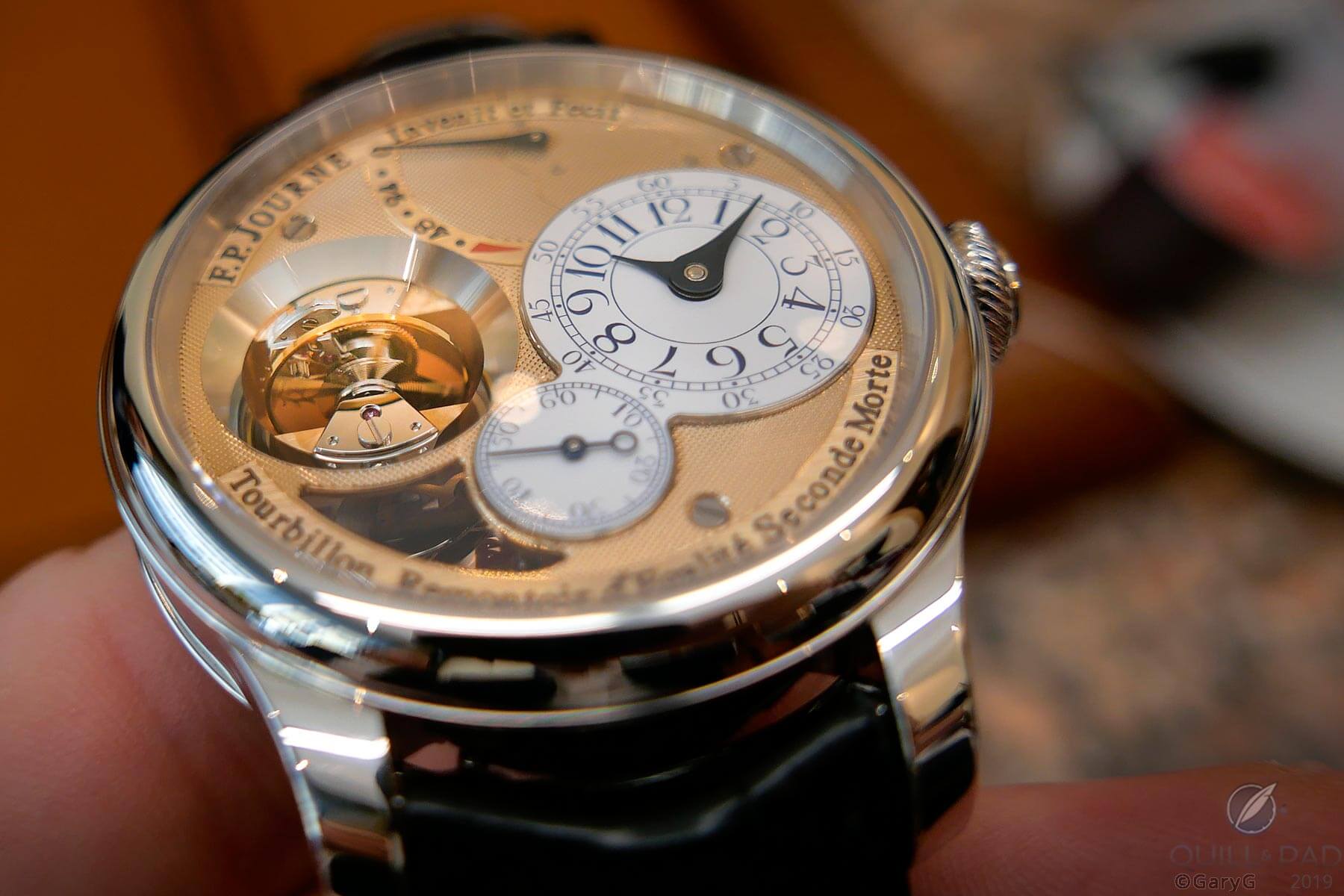
F.P. Journe Tourbillon Souverain Vertical
To subtly mask this arrangement, clous de Paris guilloche has been applied to the entire face of the movement and bridge, making them more visually indistinct. At first this might seem like a weird choice, but once you know the context you understand how it becomes a good solution.
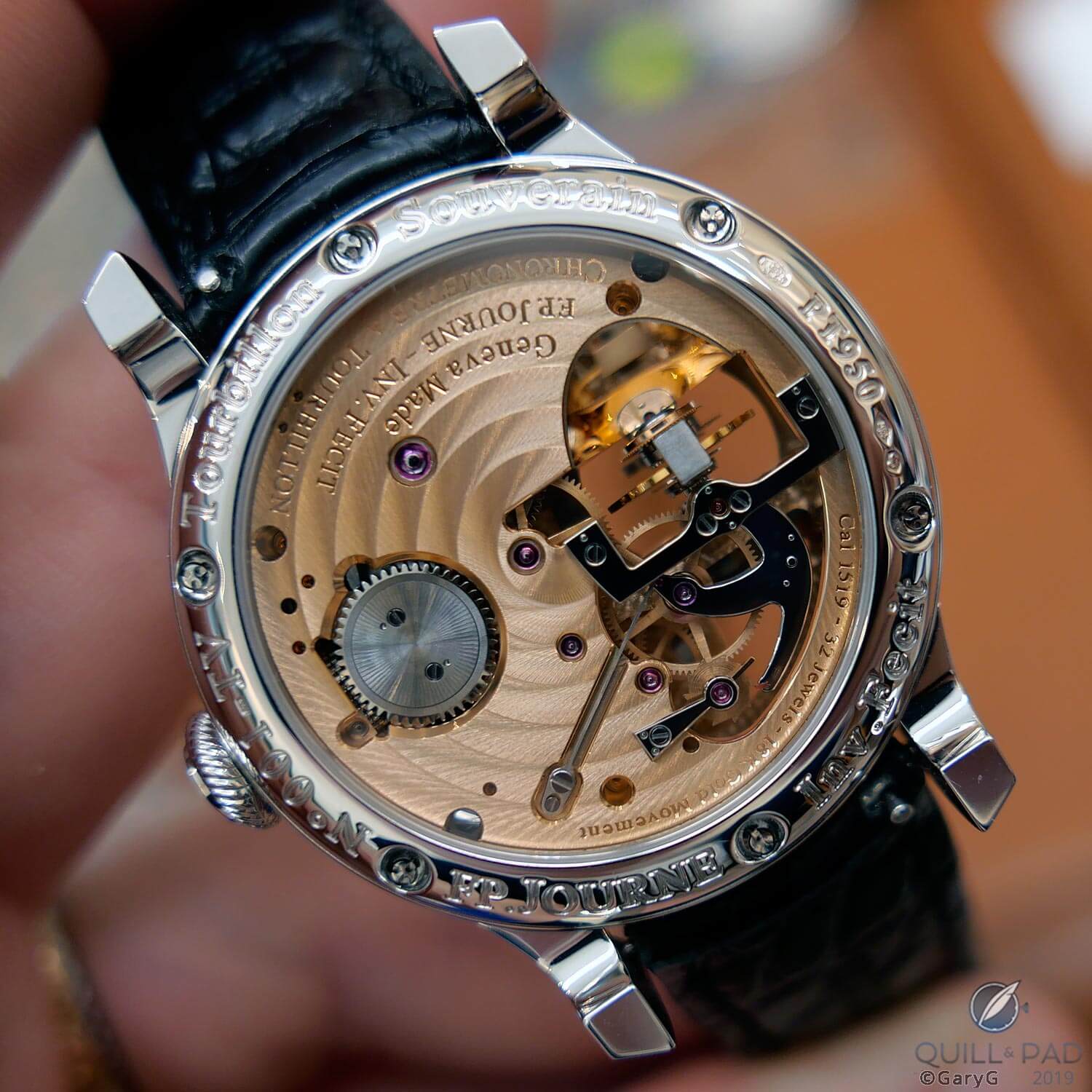
The gold movement of the F.P. Journe Tourbillon Souverain Vertical
The back side of the movement seems much more familiar for an F.P. Journe watch: the finishing, mechanical details, and style all feel like something you would see on any other piece from the brand. The only real difference is the large vertical tourbillon spinning away off to the side where a large, half conical, mirrored bevel is cut into the top plate of the movement providing more light and emphasis to the tourbillon cage from the back.
So it is clear that attention is supposed to be paid to the tourbillon. Here’s why.
F.P. Journe Tourbillon Souverain Vertical: pros and cons
The tourbillon’s position and orientation have a very clear purpose according to Journe: it’s all about consistency. Breguet’s original tourbillon was meant to average out the effects of gravity on a balance usually oriented in one position: vertical. The pocket watch was almost always in a vertical position, so the tourbillon made perfect sense.
Owners would have been encouraged to keep the watch on a pocket watch stand at night when not being worn, ensuring that the watch stays in the vertical orientation that kept the tourbillon effective. It is this that inspired F.P. Journe to create the Tourbillon Souverain Vertical.
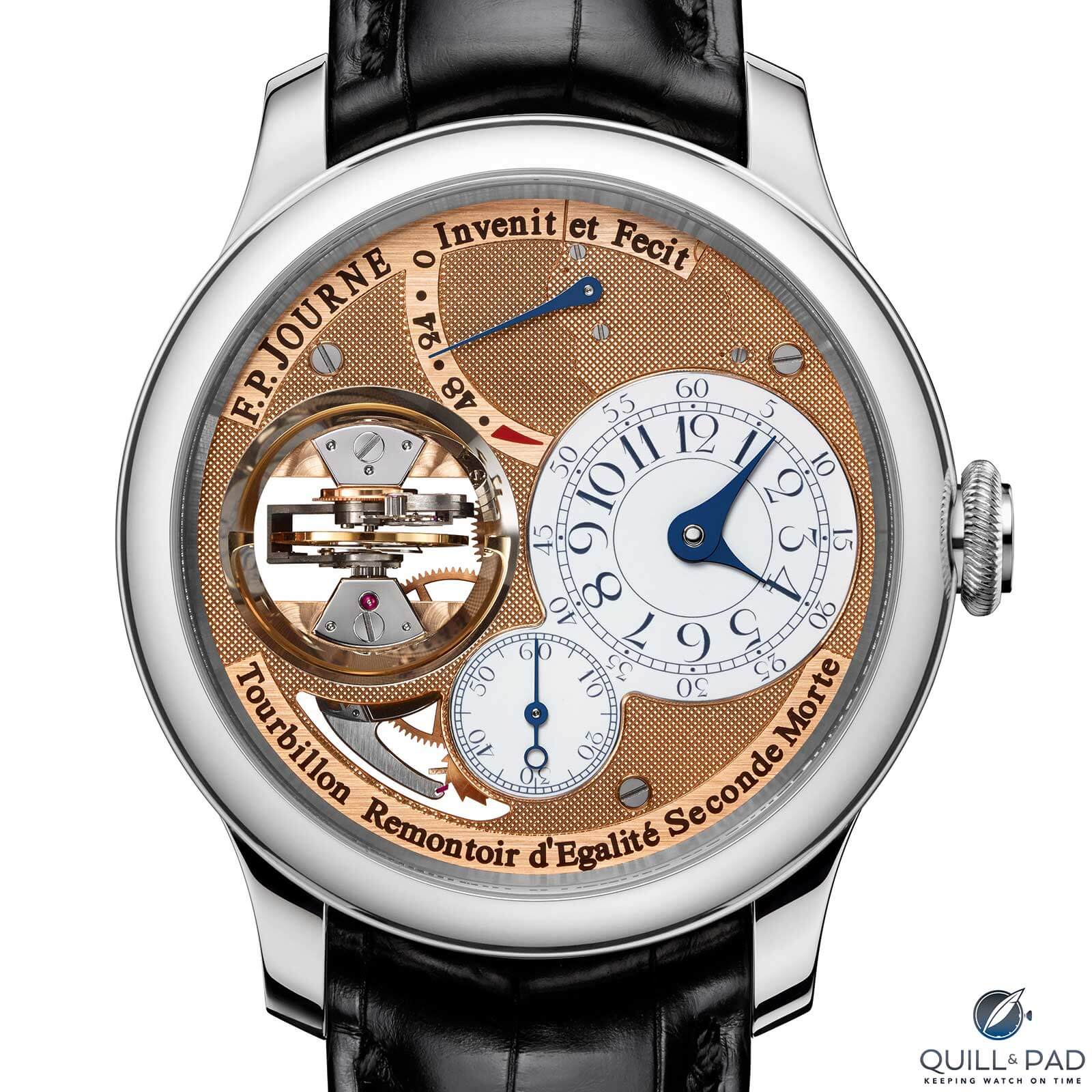
F.P. Journe Tourbillon Souverain Vertical
The daily use of the watch isn’t under scrutiny because while on the wrist the movement/balance wheel is constantly changing positions, which largely averages out positional errors. What is being addressed is the time in which the watch is stationary for a significant length, like overnight when the owner takes the watch off.
According to Journe, when the Tourbillon Vertical is stored in a flat position or on its side the tourbillon stays in the same orientation and theoretically produces more consistent timekeeping while in these positions. Of course there is no accompanying data to back this up, but in theory it might add a small (and I do mean small) benefit over a horizontal tourbillon.
The change to a vertical tourbillon over a horizontal one is more of a theoretical shift than one based on tangible benefits. There are downsides to the current configuration as well, a main one being the necessity of a 90-degree turn in the gearing, which adds complexity and friction to the movement.
The use of a smaller balance wheel also negates some advantage of a different position for the tourbillon thanks to a loss in rotational stability from a larger balance, so it is hard to say whether the practical improvement (if any) is as significant as those theoretically claimed.
Why the Tourbillon Souverain Vertical makes sense for F.P. Journe
The reasoning behind it does support the logic for inclusion of a tourbillon, a mechanism that has always had some dubious purpose in a wristwatch anyway because the escapement is usually moving through many positions throughout the day, which averages them all out. But, honestly, the possible chronometric benefit has much less to do with this watch than the creative direction taken.
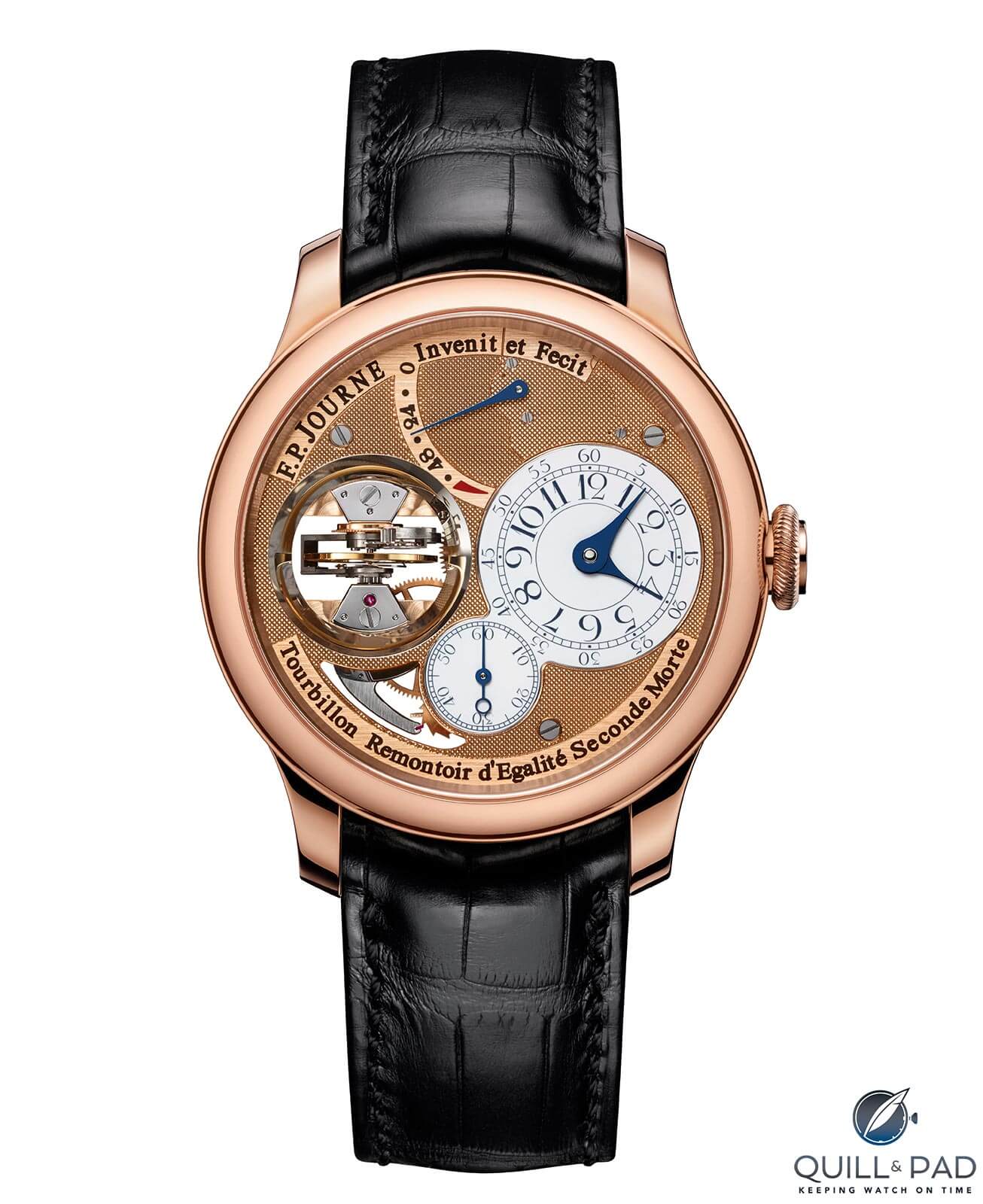
F.P. Journe Tourbillon Souverain Vertical in red gold
I think that the creation of the Tourbillon Souverain Vertical is a logical progression for F.P Journe, something that makes sense in the context of what the brand has done and what it hopes to accomplish by creating interesting and classically inspired watches of the highest caliber.
The Tourbillon Souverain Vertical might be surprising to many longtime fans of the brand, and some may be turned off to this model, but it has a place within the pantheon of great F.P. Journe watches.
If we were to imagine the inventor of the tourbillon, Abraham-Louis Breguet (1747–1823), releasing his revolving escapement under the same circumstances of career development, the reaction might have been the same. Breguet had been working for 20 years before he even started to develop his idea for a tourbillon, which was patented about five years later.
Given that during his lifetime Breguet made dozens (and possibly hundreds) of watches himself, and the watchmakers of his company made hundreds (possibly thousands) more, this would mean that many clients and observers would have had a clear idea of what Abraham-Louis Breguet would, or should, make. And perhaps some did scoff at his invention. But observers rightly understood that he was creating something new that deserved to be judged on its own merits and not what his company had previously made.
This is exactly why I don’t worry too much when a brand tries something different, especially if it is something very different than what it has made before. Creative people want to try out new ideas, and the best among them are usually rather good. It is rather clear to the collecting community that François-Paul Journe is a very discerning watchmaker, to a point that he is probably one of the most rigidly focused watchmakers on what he deems proper watchmaking.
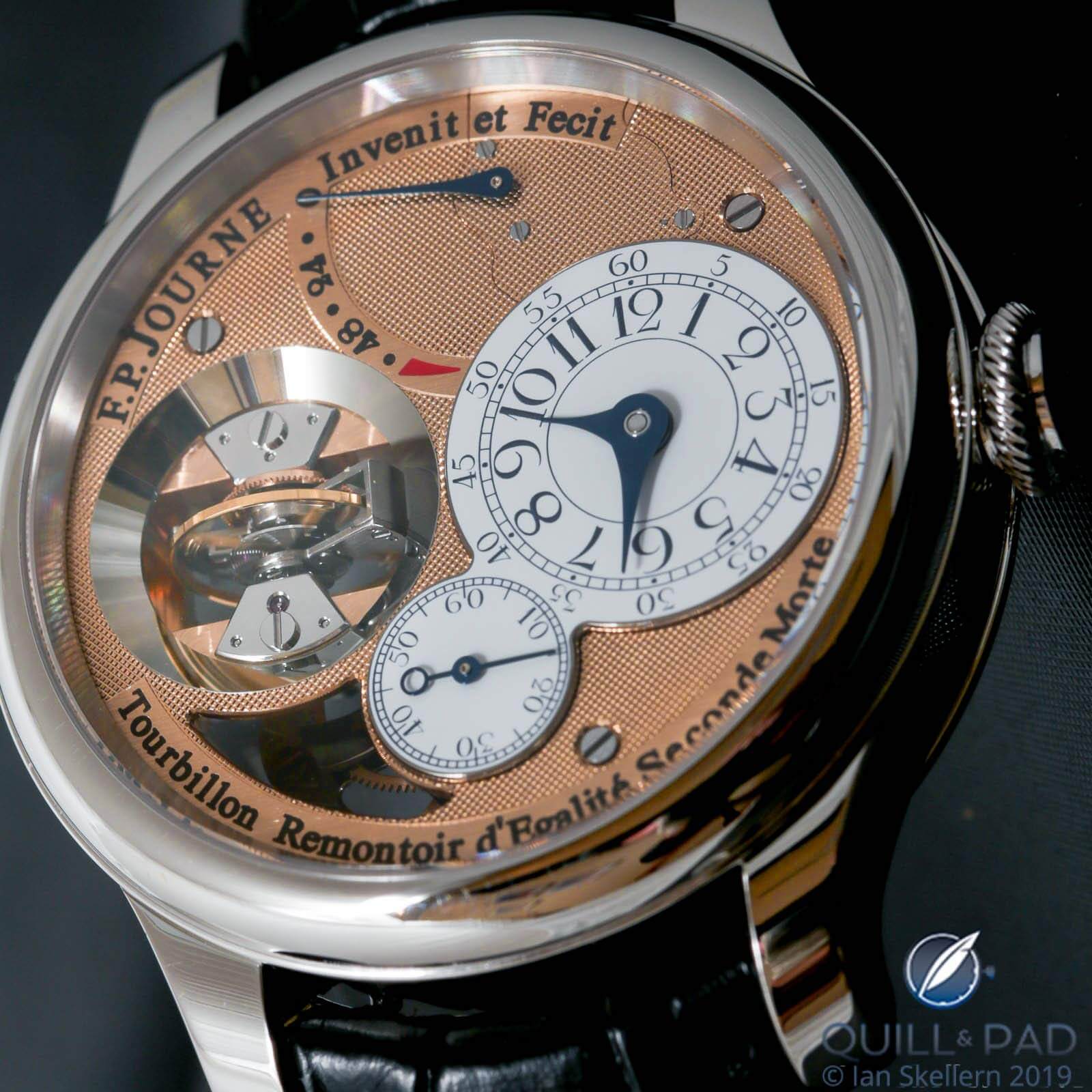
F.P. Journe Tourbillon Souverain Vertical
So if he has decided this is worthy of his time, clearly it should be given the respect and consideration that his other timepieces have received. Different isn’t bad, and the Tourbillon Souverain Vertical is an extremely cool and fresh take from a brand that stays pretty close to the style that it was born with.
I love it for what it is, and if it is meant to take the place of the original Tourbillon Souverain, a watch considered by many to be quintessentially F.P. Journe, then I say, “The king is dead, long live the king!”
Let’s break it down!
- Wowza Factor * 9.68 F.P. Journe has the ability to wow the fans of independent horology, and the new vertical tourbillon is definitely a talking piece!
- Late Night Lust Appeal * 101» 990.471m/s2 Just over the 100 g mark and more than enough to keep you up for days admiring that new tourbillon!
- M.G.R. * 68.9 Vertical tourbillon with remontoire d’egalité and dead seconds is hard to beat!
- Added-Functionitis * Mild A power reserve is always useful on manually wound watches and thus holds a position as one of the most useful added functions. The addition of this garners a need for children’s strength Gotta-HAVE-That cream for the usefully applied swelling!
- Ouch Outline * 10.8 That dull but persistent headache you get when you slept terribly the night before! Seriously, having the right bed and pillow combination can change so much. I recently had to pick up a new pillow after a woefully flat and unsupportive one led to headaches nearly every day from a strained neck. It was super helpful, but I would gladly give it back if it meant getting the Tourbillon Souverain Vertical on my wrist!
- Mermaid Moment * Five dead seconds! Having a visible mechanism delivering dead seconds is always a winner, and after just five of them you’ll be sending out invites for the ceremony in May!
- Awesome Total * 797.475 Take the number of the caliber (1519) and divide by the number of hours in the power reserve (80) and multiply the result by the diameter of the case (42) for a highly specific awesome total!
For more information, please visit fpjourne.com/collection/collection-souveraine/tourbillon-souverain-vertical.
Quick Facts F.P. Journe Tourbillon Souverain Vertical
Case: 42 x 13.6 mm, platinum or 18-karat 6N red gold
Movement: manually wound Caliber 1519 with 30-second vertical tourbillon, constant force, and dead seconds
Functions: hours, minutes, deadbeat “natural” seconds; power reserve indication
Price: CHF 244,500 (gold), CHF 248,400 (platinum)
Leave a Reply
Want to join the discussion?Feel free to contribute!





















































Certainly an interesting development from F-PJ and visually arresting. You are of course right to point out the limitation 0of the smaller balance. This could be obviated by a higher frequency but I guess this wasn’t done. Also unfortunate to introduce a contrate wheel. But full marks for a new idea.
Very enjoyable read, Joshua. The technical rationale Journe gives is sound, even if a tad superfluous – but within the horological world, what isn’t treading the line between fact and fancy?! To take this watch down to its most simplistic measure, I see the price as the only misstep. The price of the former tourbillon souveraine both new and pre-loved made it feel ‘gettable.’ Sadly, the new reference does not have that same visage. I understand my message misses the point of your article, and I in no way intend to detract, but it is hard not to approach the watch with a critical lens based on the price tag jump from reference to reference.
It is cool-looking from the dial side. But, since there’s a display window for something that moves (the Tourbillon), I would want to see that more clearly. The appeal of a Tourbillon in a wristwatch is more visual than functional, IMO. Also, it loses the amazing thinness of the previous Tourbillon Souverain case.